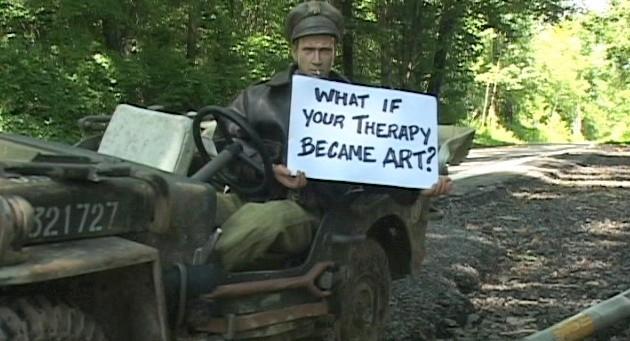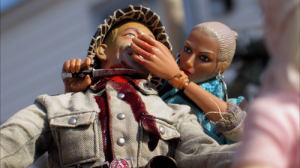So yesterday I posted saying how much I want to see the Monuments Men movie. And while I still do, I went looking up various war movies online, and stumbled across a movie that looks extremely interesting that I thought didn’t have much to do with war….at first.
There is a documentary titled ‘Marwencol,’ and it is the story of a man named Mark Hogancamp. In April 2000, Hogancamp was beaten outside of a bar and spent nine days in a coma. He suffered brain damage and an almost crushing, paralyzing anxiety after his attack. Unable to afford therapy, he began to build a 1/6-scale model Belgian village set in World War II in his yard. Acquiring several dolls, models, and other props, he began to paint them and set them up in various scenarios which didn’t have much to do with the actual war as they did with what was going on in his head. The dolls represent himself, family members, friends, and even his attackers, and he poses them to tell stories or act out various battle scenes. Usually, the various stories combine to make up a much larger narrative in which the townspeople, with help from the Allies, turn on their German overlords. Hogancamp also photographs these scenes, intentionally or unintentionally creating art. While some people will simply scoff and say the man is doing nothing more than playing with dolls, it’s important to note that Hogancamp remembers little of his life before he was beaten into a coma. The poignant scenes of death and the trauma of war shown in his photographs are countered by those of romance, love, and heroism, and perhaps in acting the scenes out, he is trying to make a connection to the life he lost and can no longer recall. Hogancamp’s fantasy-take on the war become his means of therapy, and it is only after his photos had been published in a magazine, and then displayed in a New York art gallery, that the real world he had been avoiding begins to intrude upon his less painful and fantastical existence.
I’m not by any means an expert on art, but I do believe the creation of something tangible is a great thing for both mind and soul. I’ve met several veterans of various wars that have tried their hand at creating art, whether it’s a photograph, a painting, poem, or memoir. And here is where Hogancamp’s connection to war and war veterans seems so pertinent. The continuing study of PTSD, the silent tormenter of so many of our nations veterans, has included various therapies that have been tried to reduce the psychological pain of the sufferer. Of course veterans are not the only ones to suffer from PTSD, as sex-assault victims and physically-assaulted victims can attest. PTSD has become marginally better understood just in the last decade with the wars in Iraq and Afghanistan, and several veterans throughout history have attempted their own brand of therapy by making art. However, art therapy isn’t only restricted to war veterans, but anyone that has suffered a physical or psychological wound. Of course the results of art therapy will differ from person-to-person, but the attempt in exploring one’s emotions and memories, whether repressed, or as in Hogancamp’s case, completely obliterated, is worth the challenge.
For anyone interested, here is a link to the webpage about the Documentary: Marwencol
War, Literature, & the Arts: An International Journal of the Humanities is an excellent journal with various artwork, photographs, short stories, and poems, many written by former combat and military veterans. It began in 1989 and is based at the United States Air Force Academy in Colorado. For their main webpage, visit:
War, Literature, and the Arts Journal
Or find them on Facebook:








